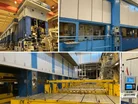Saab End-of-Life Strategy: A Scope 3 Emissions Success Story

The closure of Saab's Trollhättan factory in Sweden marks a significant shift in the automotive industry's approach to sustainability, particularly in addressing Scope 3 emissions. As car production moves towards more environmentally friendly alternatives, repurposing manufacturing machinery from this iconic plant offers a unique opportunity to reduce indirect emissions across the value chain.
The end of an era and the beginning of sustainable practices
The Trollhättan factory, which had been producing cars since 1947, shut its doors in 2023, unable to adapt to the changing landscape of EV production.
While the closure marks the end of Saab's automotive era, it opens up new possibilities for reducing the carbon footprint associated with manufacturing equipment.
Joachim Ågren, Country Manager for Sweden at Surplex, reflected on the emotional impact of the closure: "It's difficult not to get nostalgic and shed a tear. These presses have shaped Saabs that millions of Swedes have grown up with".
Repurposing machinery: A Scope 3 emissions strategy
Surplex's liquidation of the factory's equipment presents a unique opportunity to address Scope 3 emissions—those indirect emissions that occur in a company's value chain.
By giving these machines a second life, the automotive industry can significantly reduce the need for new manufacturing equipment, thereby decreasing the carbon emissions associated with the production and transportation of new machinery.
"Most of these machines can be repurposed for different industries. The possibilities are only limited by imagination."
The approach aligns with circular economy principles, extending the lifecycle of industrial equipment and reducing waste.
The environmental impact of machinery reuse
The reuse of Saab's manufacturing equipment can have a substantial impact on reducing Scope 3 emissions:
- Reduced raw material extraction: By reusing existing machinery, the demand for raw materials to produce new equipment decreases.
- Lower manufacturing emissions: Avoiding the carbon footprint of purchasing and installing new machinery.
- Decreased transportation emissions: Repurposing locally can reduce the emissions from long-distance transportation of new equipment.
Challenges and opportunities in machinery repurposing
While the potential for emissions reduction is significant, repurposing industrial equipment comes with its own set of challenges:
- Adaptation costs: Modifying machinery for new purposes may require investment.
- Technological compatibility: Ensuring older equipment meets modern manufacturing standards.
- Skill transfer: Training personnel to operate repurposed machinery in new contexts.
Despite these challenges, the opportunities for innovation and sustainability are substantial. Companies adopting this approach can significantly reduce their Scope 3 emissions while potentially discovering new, more efficient manufacturing processes.
Saab's transition: From automotive to sustainable defence
As Saab transitions from automotive manufacturing, the company is refocusing on its defence and security roots and renewing its emphasis on sustainability.
Marcus Wallenberg, Chairman at Saab, stated: "Saab's mission from the beginning has been to keep people and society safe. The expectations from our customers and society have never been greater than they are now".
The shift includes embracing new technologies that can drive sustainable growth.
"The emergence of disruptive technologies such as AI and autonomy is set to be a game-changer for our industry and reshape defence and security applications in the future".
A model for sustainable transition
The repurposing of Saab's manufacturing machinery serves as a model for how industries can creatively address Scope 3 emissions. By giving these machines a second life, companies can reduce their environmental impact, contribute to a circular economy and pave the way for more sustainable manufacturing practices across various sectors.
As the automotive industry continues to evolve towards more sustainable production methods, the legacy of Saab's Trollhättan factory lives on—not just in the cars it produced but in the machinery that will continue to shape industrial processes for years to come, contributing to a more sustainable future.
Make sure you check out the latest industry news and insights at Scope 3 Magazine and be part of the conversation at our global conference series, Sustainability LIVE and Procurement & Supply Chain LIVE.
Discover all our upcoming events and secure your tickets today. Subscribe to the Scope 3 Magazine newsletter.
Scope 3 Magazine is a BizClik brand.
- Maersk Sustainability Reporting: Navigating Scope 3Transportation & Logistics
- SHEIN’s Scope 3 Emissions: Fast Fashion’s Carbon BurdenCircular Economy
- Tackling Super Bowl LIX's Scope 3 Emissions ChallengeScope 1 2 and 3
- NetApp’s SBTi Validation Marks Sustainability MilestoneScope 1 2 and 3

